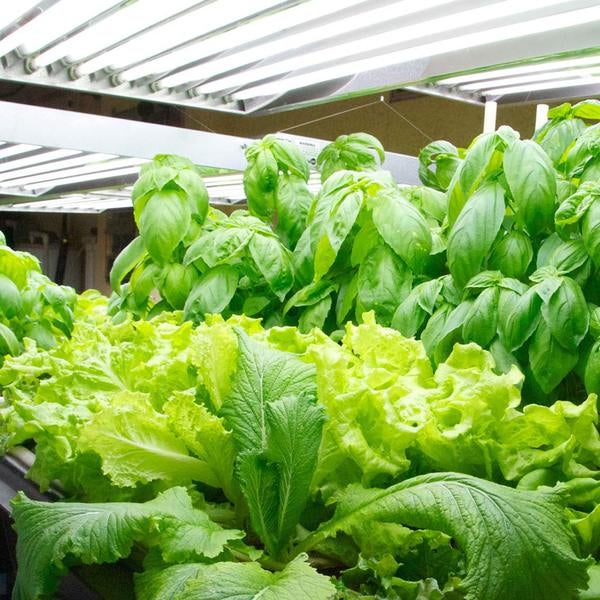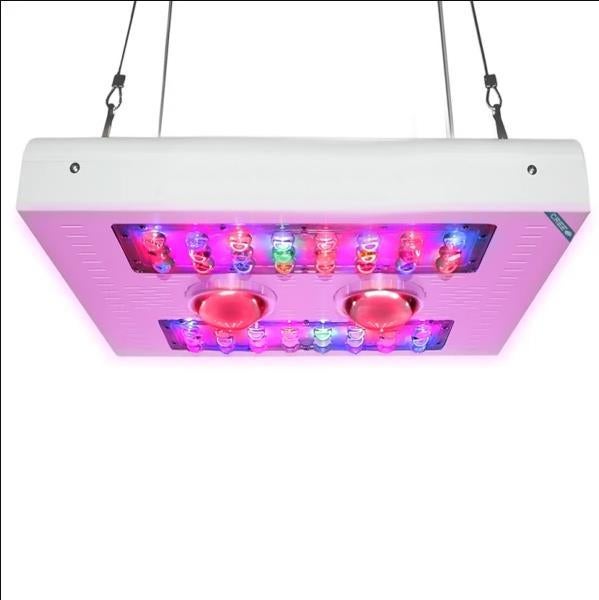T5 grow lights vs LED grow lights, Which is better?
Choosing a Grow Light for Indoor Plants
Both CFL bulbs and LEDs work great for different applications. So to choose the best one for your setup you need to consider these factors:
Plant Type and Quantity
Figure out the general size of your plants (ie herbs or bigger vegetables). Also think about how many plants you’ll want to be growing at once.
Money
Think about the price range you want for your grow light. LEDs are a bigger upfront cost than CFLs. So going the LED route will mean either growing fewer plants or shelling out more money.
Also consider how much you want to pay in power. LEDs are more efficient so will have less of an impact on your utility bill for the same number of plants.
Space and Setup
How much space do you have inside for your garden? The spae might be the limiting factor for the number of plants you grow. But if you have enough space then you’ll find the number of plants you can support with each light becomes important.
Will you have a grow tent to keep the light in? A fan to keep the light cool? Or are you hoping to set this up on a spare table? Most weed grow lights need to be suspended by a rack. But there are stand-alone LED lamps that work really well for just a few small plants each.
Will Your Plants Move to A Garden Outside?
Consider the whole lifespan of your plants before choosing a grow light. It’s a great idea to start seeds indoors and that doesn’t take much room or energy.
But those seedlings will grow up and need more room. Are you planning on keeping them inside under lights or will they move into the ground or pots outside?
Purpose
Put simply, what do you want out of your indoor garden? You don’t need a mission statement, but keep in mind why you’re growing plants indoors.
If you’re aiming for shear output of vegetables then the efficiency of your lights will be most important. If you want your setup to be flexible and let you try different types of plants then you will end up with different equipment.
Now that you’ve defined your indoor garden, let’s see if T5 Fluorescent or LEDs are better for you.
What Are Fluorescent Grow Lights?

Fluorescent lamps convert electrical energy into light by running a current through mercury vapor to produce ultraviolet radiation, which stimulates the coating of phosphor powder on the inside of the lamp to fluoresce, thus producing visible light. The color of the light is determined by the chemical composition of the phosphor.
Fluorescent grow lights come in two forms: compact fluorescent lights (CFL) and fluorescent tubes. CFL grow lights differ from regular CFLs in that they come in larger sizes, provide higher wattages, and put out a broad spectrum of light.Fluorescent tube grow lights come in different sizes and varieties, although the T5 diameter high-output (HO) grow lights, which emit about twice as much light as regular fluorescent tubes, are widely considered the best ones to use.Fluorescent grow light fixtures typically have built-in reflectors and ballast, which give them a thin profile.
T5
The T5 line are high output fluorescent bulbs that are able to give you plenty of power, especially in smaller spaces. They are very energy efficient, although their low light penetration levels do require a bit of finesse when assembling your setup. They give off very little heat, making them excellent when used in smaller spaces, also saving on your power bill compared to many other available lighting options
Pros
T5 Grow lights are rated for around 30,000 hours, making them some of the most long-lasting bulbs available. They don’t quite match up with the lifetime of LEDs, but do produce more light per watt than LEDs, meaning they are able to streamline your setup and make it much more efficient, especially when in vegetative and flowering stages of growth. The fact that they emit less heat than most other lighting options means you can hover them directly above plants, with a gap of only 1-2 inches, maximizing your efficiency in smaller spaces.
Cons
Depending on your current setup or available fixtures, taking the T5 route may require you to purchase a new or replacement ballast, which is going to set you back a little to begin with, but this cost isn’t overly taxing, especially compared to the high startup costs associated with LEDs. The T5s will end up being a little more costly further down the road when compared with LEDs, but it really all comes down to what your specific operation needs.
What Are LED Grow Lights?

LED stands for light-emitting diode. A form of solid-state lighting, an LED uses a semiconductor chip, known as an LED die, that turns an electrical current into photons through a process called electroluminescence. An LED may be configured either as a single-die emitter that’s mounted on a circuit board, or an array of dies mounted directly on a circuit board, which is known as a chip-on-board (COB) module. An LED lamp is made up of an LED mounted to a heat sink, along with directional lenses and a power supply.
Today’s LED grow lights are designed to emit wavelengths of light that produce the natural daylight spectrum, or they can be precisely adjusted to put out ideal wavelengths for the varying needs of growing plants. They feature additional cooling systems to increase their efficiency.
LEDs
While LEDs are fairly new to the scene, they are turning heads in a big way, offering excellent output while remaining incredibly energy efficient, even outperforming T5 lights in the long run. They do require you to spend a little more on fixtures when starting out, but will make up for this added cost by maintaining an amazingly reasonable power draw. This means that if you want your setup to last for a long time and still maintain peak efficiency, LEDs are a solid bet.
Pros
LEDs are known for their benefits regarding both power efficiency and lifespan. LEDs are rated to last up to 50,000 hours and use only 15W/hr per 4’ tube. No ballast is needed for LEDs, which avoids a certain amount of hassle, although wiring can be somewhat tricky for those who don’t quite know what they’re doing. The fact that LEDs don’t require a ballast does add some adaptability if you opt to tweak your setup, whereas T5s are a little less so.
Cons
As we mentioned, LEDs will usually require some basic understanding of wiring, but it isn’t too difficult to pull off on your own. That being said, we recommend that you hire a professional if you are at all unsure, as you don’t want to take any chances when it comes to getting shocked.

Comparison Of LED vs Fluorescent Grow Lights
Now, let’s look at the numbers and compare LED and fluorescent grow lights in respect to specific aspects:
Efficiency
When it comes to energy efficiency, Hydroponics LED grow lights beat out the best fluorescent grow lights, hands down. When comparing lighting efficiency, it’s important to look at the light levels delivered to plants rather than just the electrical watts. A 300-watt LED lamp is equal to a 600-watt T5 fluorescent grow tube in terms of micromole of photons per Joule of energy, thus saving about 50 percent of the light energy required while providing the equivalent level of light.
Color temperature/light wavelength output/PAR
As for a comparison of light energies, some explanation of terms used to describe horticultural lighting is in order, as this can be confusing if you’re new to hydroponic growing.
Light wavelength output refers to the colors of the spectrum that are present in the light emitted by a lamp, as measured in nanometers. While sunlight contains the full spectrum of light energy, we humans can only see part of the light energy spectrum. Likewise, the pigments and photoreceptors in plants only respond to certain wavelengths of light.
Color temperature offers a sense of the light spectrum in terms of cool colors, which are in the blue range, and warm colors, which are the reds.
PAR stands for photosynthetically active radiation, which is the range usable light energy that most plants absorb for photosynthesis.
Hydroponics enthusiasts tend to get caught up in the minutiae of light energy and its effects on plant growth. But basically, while fluorescent bulbs are now available that put out a variety of cool, warm, and full spectrum lighting, LED technology enables an unlimited variety of precision outputs ranging from broad-spectrum white light that’s remarkably close to sunlight to lighting that growers can use for intricately specific purposes, such as encouraging basil plants to develop a stronger flavor.
Lifetime Of LED vs Fluorescent Grow Lights
Here again, LED grow lights really outshine fluorescent grow lighting, with LEDs having a usable lifespan of about 50000 hours, as compared to about 8000 hours for CFL grow lights and 10000 to 20000 hours for T5 fluorescents.
Cost Of LED vs Fluorescent Grow Lights
Although their prices are coming down, LED grow lights are still significantly more expensive than fluorescent grow lights to purchase. However, LED lamps use half the energy that fluorescents use to put out the same amount of light and can last up to eight times longer. So the overall cost of LEDs comes out lower in the long run than purchasing and running fluorescent grow lighting for hydroponic gardening.
Conclusion
While both T5s and LEDs are leagues above any other lighting options, they are very similar to each other in all the areas where it really counts. Many growers will use a combination of both T5s and LEDs to maximize their efficiency, with both drawing very little power and producing very little heat. LEDs do last longer and are more efficient in the long run, but T5s are better able to specialize during certain stages of growth. Furthermore, LEDs will cost more right off the bat, with T5s ending up being minimally more expensive further on down the road. With the two options being fairly similar, this is the only major difference in the two, although LEDs are growing in popularity and their versatility is unparalleled.
评论
发表评论